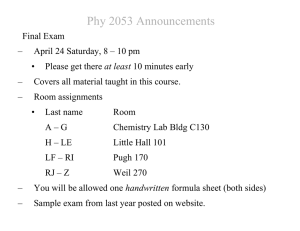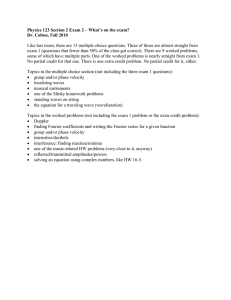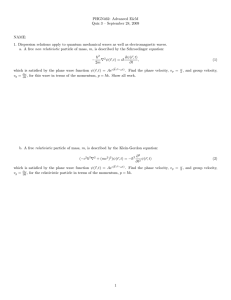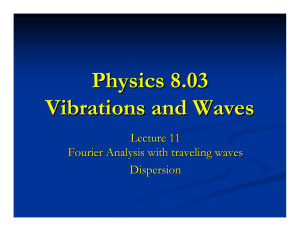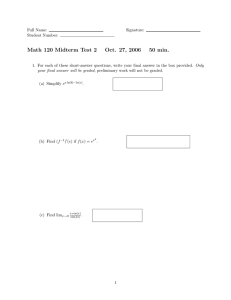Acos ωt - Department of Physics | Oregon State University
advertisement
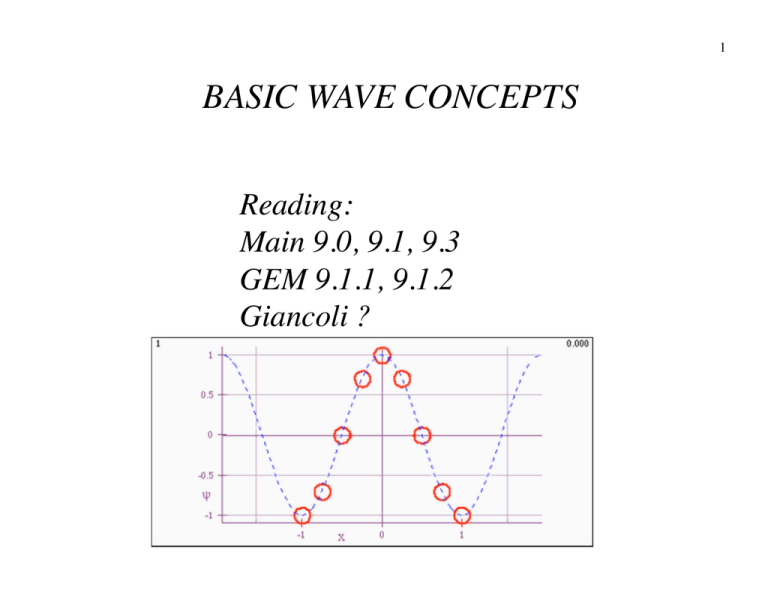
1 BASIC WAVE CONCEPTS Reading: Main 9.0, 9.1, 9.3 GEM 9.1.1, 9.1.2 Giancoli ? 2 REVIEW SINGLE OSCILLATOR: The oscillation functions you’re used to describe how one quantity (position, charge, electric field, anything ...) changes with a single variable, TIME. 3 ψ (t) = A cos(ωt + φ ) 2π 1 period T = = ω f position 1A ψ -0.25 0.25 0.75 -1 -A φ t=− ω time 1.25 1.75 4 Oscillations in time ψ (t) = A cos(ωt + φ ) 2π 1 T= = ω f (Cyclic) frequency, f (or ν), dimension: [time-1] Angular frequency, ω, dimension: [time-1] Period, T, dimension: [time] Amplitude A, or ψ0, dimension: [whatever] Phase, ωt+φ, dimensionless Phase constant, φ, dimensionless 5 Equivalent representations ……. ψ (t) = Acos(ωt + φ ) ψ (t) = B p cos(ωt ) + Bq sin(ωt ) ψ (t) = Ce i(ωt ) + C * e−i(ωt ) ψ (t) = Re[ De iωt ] Remember the conversions between A, B, C, D forms - see Main Ch. 1. 6 If we have SEVERAL oscillators at different positions, we can describe the variation of that same quantity (call it ψ) by a function of TWO variables: TIME, just like before, and another variable, POSITION, which identifies the location of the oscillator. Watch the animation. What can you say about the amplitude, frequency and phase of each oscillator? Which direction does each oscillator travel? Which way does the wave travel? ψ (x) = A cos(kx + φ ) At a FIXED TIME, wavelength position 1 2π λ= k A ψ -0.25 -1 0.25 0.75 -A time space 1.25 1.75 7 8 Periodic variations in space ψ (x) = Acos( kx + φ ) 2π λ= k Wave “vector”, k, dimension: [length-1] (wave number is 1/λ) Wavelength, λ, dimension: [length] Amplitude A, or ψ0, dimension: [whatever] Phase, kx+φ, dimensionless Phase constant, φ, dimensionless 9 Waves - functions of space AND time Looking ahead…. We will discuss mostly harmonic waves where variations are sinusoidal. Traveling and standing waves Damped, (driven) waves Reflection, transmission, impedance Classical and quantum systems 10 Traveling wave ψ (x,t) = A cos(ωt + kx + φ ) Standing wave ψ (x,t) = A cos ( kx ) cos (ω t ) Traveling waves - functions of ωt±kx ψ (x,t) = A cos (ω t ± kx + φ ) 2π 2π λ= ;T = k ω Disturbance propagates … what speed? Look at one particular feature (constant phase) d (ω t ± kx ) = 0 ω dt ± kdx = 0 dx ω λ = = dt k T v = dx/dt or phase velocity is velocity of one particular feature. If we had ψ = Acos(ωt-kz), it would be v=dz/dt. 11 12 Traveling waves - functions of vt±x ψ (x,t) = A cos (ω t ± kx + φ ) ψ (x,t) = A cos[k (vt ± x) + φ ] 2π 2π λ= ;T = k ω vt-x disturbance travels in direction of increasing x (t↑⇒ x↑ for constant phase) vt+x: travels in direction of decreasing x (t↑⇒ x↓ for constant phase) Traveling waves are superpositions of standing waves 13 Focus on the green circle that marks a maximum (a particular phase) phase velocity, vphase= ω/k =λ/T, dimensions [length. time -1] 14 Another velocity - material/field velocity When a wave or disturbance propagates, the particles of the MEDIUM do not propagate, but they move a little bit from their equilibrium positions material velocity, vmat=∂ψ/∂t, dimensions [ψ. time -1] Material/field velocity is speed of the “waving thing” in the medium. If ψ has dimensions of length, this is a velocity as we normally think of it. But waves don’t necessarily need a medium in which to propagate and ψ might well represent something more abstract like an electric field. If you think of a better name, let me know! 15 Focus on the red circle that marks a particular x Material/field velocity, vmat=∂ψ/∂t, dimensions [ψ. time -1] 16 Material/field velocity vmat=∂ψ/∂t dimensions [ψ. time -1] If the material/field velocity is perpendicular to the phase velocity, the wave is “transverse”. Examples? If the material/field velocity is parallel to the phase velocity, the wave is “longitudinal”. Examples? Combinations of the above are possible. Examples? Show wave machine 17 Another velocity – group velocity There is another way to make something that has the dimensions of a velocity: Group velocity, vgroup=∂ω/∂k, dimensions [length. time -1] This describes the propagation of a feature in a “wave packet” or superposition of waves of different frequencies. We will come back to this concept later. 18 Standing waves - functions of x (only) multiplied by functions of t (only) ψ (x,t) = A cos(kx) sin(ωt ) Standing waves are superpositions of traveling waves Also find mixtures of standing waves and traveling waves 19 ψ (x,t) = A cos(ωt − kx + φ ) ψ (x,t) = B p cos(ωt − kx) + Bq sin(ωt − kx) i ( ωt−kx ) −i ( ωt−kx ) ψ (x,t) = Ce +C *e i ( ωt−kx+φ ) ψ (x,t) = Re[ De ] Same conversions between A, B, C, D forms as for oscillations - see Main Ch1, Ch9. Other waveforms (e.g.) sawtooth, pulses etc., can be written as superpositions of harmonic waves of different wavelengths and/or frequencies … Fourier series and Fourier integrals (transforms) 20 How do these functions arise? PROVIDED ω/k = v, a constant, they are solutions to the differential equation: (non-dispersive wave equation) ∂2 1 ∂2 ψ (x,t) = 2 2 ψ (x,t) 2 ∂x v ∂t This DE results when: Newton’s law is applied to a string under tension Kirchoff’s law is applied to a coaxial cable Maxwell’s equations are applied to source-free media … and many other cases … 21 BASIC WAVE CONCEPTS -REVIEW • • • • • • • • Wavelength, wavevector, frequency - angular and cyclic, period, phase, phase constant, phase velocity, group velocity, material/field velocity, direction of travel, transverse & longitudinal wave, superposition, traveling wave <-> standing wave, (non-dispersive) wave equation Mathematical representations of the above, including A,B,C,D forms of 2-variable function

